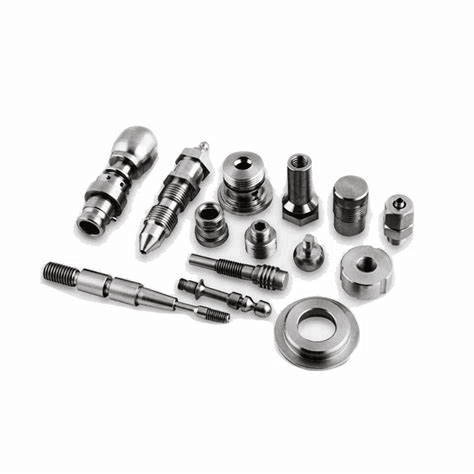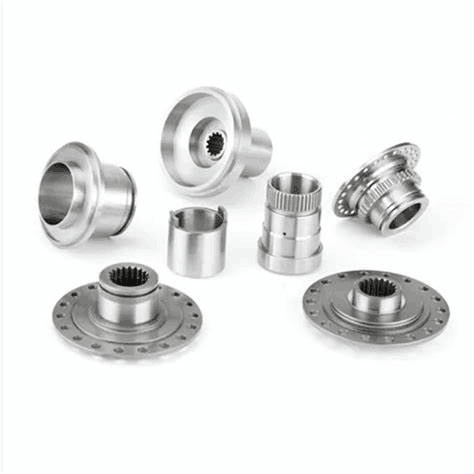BETTER TOUCH BETTER BUSINESS
Contact Sales at Lori.
The term CNC stands for "computer numerical control," and CNC machining is defined as a subtractive manufacturing process that typically uses computer control and machine tools to remove layers of material from stock parts (called blanks or parts) and produce custom-designed parts.
The process is suitable for a variety of materials, including metal, plastic, wood, glass, foam, and composite materials, and is used in a variety of industries, such as large CNC machining and CNC finishing aerospace parts.
CNC machining features
1.high degree of automation, production efficiency is very high. Except for blank clamping, all other processing processes can be completed by CNC machine tools. If combined with the automatic loading and unloading method, it is the basic component of the unmanned control factory.
CNC machining reduces the labor of the operator, improves the working conditions, eliminates the marking, multiple clamping positioning, detection and other processes and auxiliary operations, and effectively improves the production efficiency.
2.the adaptability of CNC processing objects. When changing the processing object, in addition to changing the tool and solving the blank clamping method, only need to reprogram, without other complex adjustments, shorten the production preparation cycle.
3.high processing precision, stable quality. The dimensional accuracy of the machining is between d0.005-0.01mm, which is not affected by the complexity of the parts, because most of the operations are automatically completed by the machine. Therefore, the size of the batch parts is improved, and the position detection device is also used on the precision controlled machine tool, which further improves the precision of precision CNC machining.
4.CNC machining has two main characteristics: first, it can greatly improve the processing accuracy, including the processing quality accuracy and processing time error accuracy; The second is the repeatability of the processing quality, which can stabilize the processing quality and maintain the quality of the processed parts.

CNC machining technology and scope of application
According to the material and requirements of the machined part, different processing methods can be selected, and understanding the common machining methods and scope of application can allow us to find the most suitable parts processing method.
Turning process
The methods of machining parts using lathes are collectively referred to as turning processing. Using the forming tool, the rotary surface can also be machined when the transverse feed. Turning can also be processed thread surface, end plane and eccentric shaft.
The turning accuracy is generally IT11-IT6, and the surface roughness is 12.5-0.8μm. When finishing, it can reach IT6-IT5, and the roughness can reach 0.4-0.1μm. The productivity of turning processing is higher, the cutting process is relatively stable, and the tool is simple.
Scope of application: drilling center hole, drilling, reaming, tapping, turning round, boring, turning end face, turning groove, turning forming surface, turning cone, knurling, turning thread
Milling
Milling is a method of machining the part using a rotating multi-edge tool (milling cutter) on a milling machine, and the main cutting motion is the rotation of the tool. According to the direction of the main motion speed during milling and the feed direction of the part is the same or opposite, and it is divided into up-milling and up-milling.
(1) Down milling
The horizontal component of the milling force is the same as the feed direction of the part, and there is generally a gap between the feed screw and the fixed nut on the part table, so the cutting force is easy to cause the part and the table to move forward together, so that the feed suddenly increases, causing the cutting tool.
(2) Inverse milling
It can avoid the movement phenomenon that occurs during downmilling. In reverse milling, the cutting thickness gradually increases from zero, so the blade begins to undergo a period of extrusion sliding on the machined surface of the cut hardening, accelerating tool wear.
Scope of application: milling plane, milling step, milling groove, milling forming surface, milling spiral groove, milling gear, cutting
Planing
Planing processing generally refers to the processing method of cutting excess materials on the planer by using the planer knife to do reciprocating linear motion relative to the part.
The planing accuracy is generally up to IT8-IT7, the surface roughness is RA6.3-1.6μm, the planing flatness is up to 0.02/1000, and the surface roughness is 0.8-0.4μm, which has advantages for the processing of large castings.
Scope of application: planing plane, planing vertical face, planing step surface, planing right Angle groove, planing bevel, planing dovetail groove, planing t-shaped groove, planing surface, planing inner keyway, planing rack, planing composite surface

Grinding
Grinding process is the use of high hardness artificial grinding wheel (grinding wheel) as a tool, the part surface on the grinding machine cutting method, the main movement is the rotation of the grinding wheel.
The grinding accuracy can reach IT6-IT4, and the surface roughness Ra can reach 1.25-0.01μm, or even 0.1-0.008μm. Another feature of grinding is that hardened metal materials can be processed, which belongs to the range of finishing, so it is often used as a final processing process. According to different functions, grinding can also be divided into cylindrical grinding, internal grinding, flat grinding and so on.
Scope of application: external grinding, internal grinding, surface grinding, form grinding, screw grinding, gear grinding
Drilling process
The process of machining various internal holes on the drilling machine is called drilling processing, and it is the most common method of hole processing.
The drilling processing accuracy is low, generally IT12~IT11, the surface roughness is generally Ra5.0~6.3um, and the semi-finishing and finishing are often carried out by reaming and reaming after drilling. The precision of reaming is generally IT9-IT6, and the surface roughness is RA1.6-0.4μm.
Scope of application: drilling, reaming, reaming, tapping, strontium hole, scraping plane
Boring machining
Boring process using boring machine to enlarge the aperture and improve the quality of the existing hole processing method, boring processing is based on the rotary movement of the boring tool.
The boring processing accuracy is high, generally IT9-IT7, and the surface roughness is RA6.3-0.8mm, but the production efficiency of the boring processing is low.
Scope of application: machining high-precision holes, multi-hole finishing
Tooth surface machining
Gear tooth surface machining methods can be divided into two categories: forming method and developing method.
The machine tool used to process the tooth surface is generally an ordinary milling machine, and the tool is a forming milling cutter, which requires two simple forming motions of the rotary motion and linear movement of the tool. The commonly used machine tools for tooth surface processing are gear hobbing machine, gear shaper machine, etc.
Scope of application: gears, etc
Complex surface machining
The cutting of three-dimensional surface mainly adopts the method of contour milling and CNC milling or special machining method.
Scope of application: complex surface parts
Electric discharge machining
Edm is the use of tool electrode and part electrode instantaneous spark discharge between the high-temperature corrosion of the part surface material to achieve machining.
Scope of application:
① Processing hard, brittle, tough, soft and high melting point conductive materials;
② Processing semiconductor materials and non-conductive materials;
③ Processing all kinds of shaped holes, curved holes and tiny holes;
④ Processing a variety of three-dimensional curved cavity, such as forging die, die casting die, plastic die die;
⑤ Used for cutting, cutting and surface strengthening, engraving, printing nameplates and marks.
Electrochemical machining
Electrochemical machining (ECM) is a method of forming the part by using the electrochemical principle of anode dissolution of the metal in the electrolyte.
The part is connected to the positive electrode of the DC power supply, the tool is connected to the negative electrode, and the gap between the two poles is kept narrow (0.1mm ~ 0.8mm). The electrolyte with a certain pressure (0.5MPa ~ 2.5MPa) flows through the gap between the poles at a high speed of 15m/s ~ 60m/s.
Scope of application: machining hole, cavity, complex surface, small diameter deep hole, rifling and deburring, engraving, etc.
Laser processing
The laser processing of the part is completed by the laser processing machine. Laser processing machine is usually composed of laser, power supply, optical system and mechanical system.
Scope of application: diamond wire drawing die, clock gemstone bearing, porous skin of divergent air cooling stamping, engine fuel nozzle, aero engine blade and other small hole processing and a variety of metal materials and non-metal materials cutting processing.
Ultrasonic machining
Ultrasonic machining is a method that uses ultrasonic frequency (16KHz ~ 25KHz) vibration tool end face to impact the suspended abrasive in the working fluid, and the abrasive particles impact and polishing the part surface to realize the part processing.
Scope of application: hard to cut materials
Copyright © 2025 Shenzhen Lori Technology Co.Ltd. | All Rights Reserved.